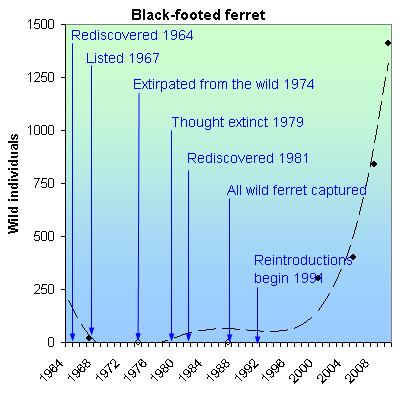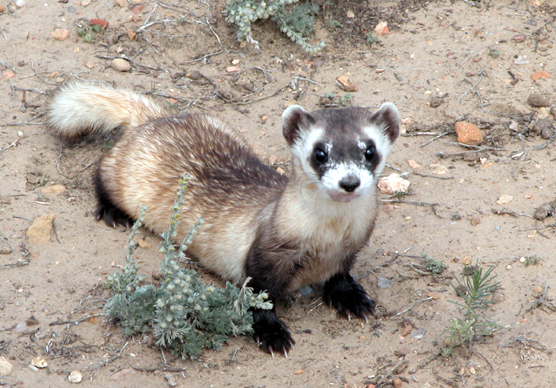Sydney Matteson
The Ferret
Black-footed ferrets are apart of the weasel family, they are only species of ferret native to North America, while all other ferrets are domesticated european ferrets. They have long slender bodies with distinct black fur on their legs and a black mask like pattern on their faces. On average, black-footed ferrets are 18-24 inches long and 6 inches tall. The male ferrets tend to weight 1.5-2.5 pounds and the females are slightly smaller. In captivity they live about 5 years longer than in the wild (3-4 years).
Black-footed ferrets are apart of the weasel family, they are only species of ferret native to North America, while all other ferrets are domesticated european ferrets. They have long slender bodies with distinct black fur on their legs and a black mask like pattern on their faces. On average, black-footed ferrets are 18-24 inches long and 6 inches tall. The male ferrets tend to weight 1.5-2.5 pounds and the females are slightly smaller. In captivity they live about 5 years longer than in the wild (3-4 years).
The Dependance on Prairie Dogs
Over 90% of the their diet is prairie dog, but also eat other rodents such as mice and squirrels. Prairie dogs are crucial to the black-footed ferrets because they are not only the ferrets prey, but they use the prairie dogs burrows as their own. They spend most of their time in the burrows and only come out at night to hunt.
Over 90% of the their diet is prairie dog, but also eat other rodents such as mice and squirrels. Prairie dogs are crucial to the black-footed ferrets because they are not only the ferrets prey, but they use the prairie dogs burrows as their own. They spend most of their time in the burrows and only come out at night to hunt.
 |
| The historic range of the black-footed ferret with reintroduction sites. Photo by Black-footed Ferret Recovery Program |
Historically, the ferrets colonized the grasslands of the Great Plains from northern Mexico to southern Canada. In 1986, the black-footed ferrets were thought to be extinct because they couldn’t be found anywhere within their natural range. In order to restore previous populations, 18 ferrets were captured and put into a captive breeding program.
The Decline
The ferrets near extinction was a result of expansion to the West, farmers needed more agricultural land for crops and cattle. However, the agricultural land destroyed the habitat for the prairie dogs and farmers were poisoning them because they were eating the grass that their cattle needed. This caused the decline in prairie dog populations. Consequently, this had a direct effect on the ferrets population which also declined. The ferret population also declined from an exotic disease called the Sylvatic plague (also affected the prairie dogs). Black-footed ferret populations declined so much that they were listed as endangered in 1967 and later grandfathered into the Endangered Species Act of 1973.
The ferrets near extinction was a result of expansion to the West, farmers needed more agricultural land for crops and cattle. However, the agricultural land destroyed the habitat for the prairie dogs and farmers were poisoning them because they were eating the grass that their cattle needed. This caused the decline in prairie dog populations. Consequently, this had a direct effect on the ferrets population which also declined. The ferret population also declined from an exotic disease called the Sylvatic plague (also affected the prairie dogs). Black-footed ferret populations declined so much that they were listed as endangered in 1967 and later grandfathered into the Endangered Species Act of 1973.
The Goal
The Endangered Species Act’s main goal for the ferrets is to have them listed as threatened instead of endangered and eventually taken off the list completely. This means getting their population's back to a healthy and productive level. The U.S. Fish & Wildlife Service defines this in the Black-Footed Ferret Recovery Plan as:
The Endangered Species Act’s main goal for the ferrets is to have them listed as threatened instead of endangered and eventually taken off the list completely. This means getting their population's back to a healthy and productive level. The U.S. Fish & Wildlife Service defines this in the Black-Footed Ferret Recovery Plan as:
- A captive breeding population of black-footed ferrets with a minimum of 280 adults (105 males, 175 females) distributed among at least three facilities.
| The average litter size is 3-4 kits (baby black-footed ferrets). The kits don't open their eyes until 21 days after their birth. Photo by zooborns.com |
- Establish free-ranging black-footed ferrets with at least 3,000 breeding adults, in 30 or more populations, with at least one population in each of at least 9 of 12 States within the historical range of the species, with no fewer than 30 breeding adults in any population, and at least 10 populations with 100 or more breeding adults, and at least 5 populations within colonies of Gunnison’s and white-tailed prairie dogs.
- Maintain these population objectives for at least three years prior to delisting.
- Maintain a total of approximately 494,000 acres of prairie dog occupied habitat at reintroduction sites by planning and implementing actions to manage plague and conserve prairie dogs.
- Complete and implement a post-delisting monitoring and management plan, in cooperation with the States and Tribes, to ensure recovery goals are maintained.
The primary actions that are detailed in the plan are to improve prairie dog management and protect against sylvatic plague. The full recovery plan can be found here.
A brief overview of the black-footed ferret captive breeding efforts.
Video by National Geographic
 |
| Graphed timeline of black-footed ferret populations from 1964 to the present. Photo by esasuccess.org |
Currently they are about 1,000 individual ferrets in the wild and hundreds in captivity programs that are being bred and reintroduced into their historic ranges. The efforts of many organizations including World Wildlife and The Black-footed Ferret Recovery Implementation Team are slowly progressing to the successful recovery of the black-footed ferret.
Sources:

Great article thought you should check your sources the current number of individuals in the wild is 300-500. The original spectations were to get to 1500 by 2023.
ReplyDelete